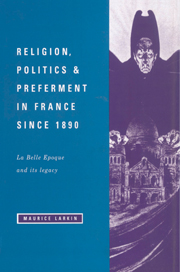Book contents
- Frontmatter
- Contents
- Preface
- Part 1 As it was: Catholics and the Republic, 1890–1914
- Part 2 As it was: Catholics and state employment, 1890–1914
- 4 Problems and principles
- 5 Patterns of preferment: sectors with teeth
- 6 Ronds-de-cuir, genoux-de-chameau: other sectors
- 7 The Brotherhood at work
- 8 Marianne at school
- Part 3 As it became, 1914–1994
- Map: Religious observance in France, c. 1960.
- Notes
- Sources
- Index
5 - Patterns of preferment: sectors with teeth
Published online by Cambridge University Press: 27 January 2010
- Frontmatter
- Contents
- Preface
- Part 1 As it was: Catholics and the Republic, 1890–1914
- Part 2 As it was: Catholics and state employment, 1890–1914
- 4 Problems and principles
- 5 Patterns of preferment: sectors with teeth
- 6 Ronds-de-cuir, genoux-de-chameau: other sectors
- 7 The Brotherhood at work
- 8 Marianne at school
- Part 3 As it became, 1914–1994
- Map: Religious observance in France, c. 1960.
- Notes
- Sources
- Index
Summary
It was recognised by politicians of most persuasions that a major distinction had to be made between those ministries that were the instruments of the overall thrust of a government's policies – such as the Ministry of the Interior – and the more technical ministries, such as Agriculture and Public Works, whose expertise was directed to specific material problems, requiring professional rather than political judgement. It was accepted with varying degrees of conviction that the government needed to assure itself of loyal and understanding executants of its policies in the first category of ministry; and many politicians believed that a major change of government justified a corresponding change in senior personnel in such ministries. Few, on the other hand, thought this necessary in the technical ministries. Violent disagreement arose, however, as to which ministries should be in which category, and on how far down the administrative ladder changes of faces were justified. There was notoriously bitter controversy as to whether the Ministry of Justice belonged to the first group or the second; and endless dispute as to whether the personal, political and religious beliefs of public servants could legitimately disqualify them for various sectors of the administration.
These arguments reflected the fact that the concept of civil-service neutrality was much slower to develop in France than in Britain; and although French politicians never admitted to having an American-style spoils system, they harboured a certain tacit envy of it. Unlike Britain, France in the nineteenth century had undergone a succession of regimes, with violence accompanying many of the changes.
- Type
- Chapter
- Information
- Religion, Politics and Preferment in France since 1890La Belle Epoque and its Legacy, pp. 88 - 106Publisher: Cambridge University PressPrint publication year: 1995



